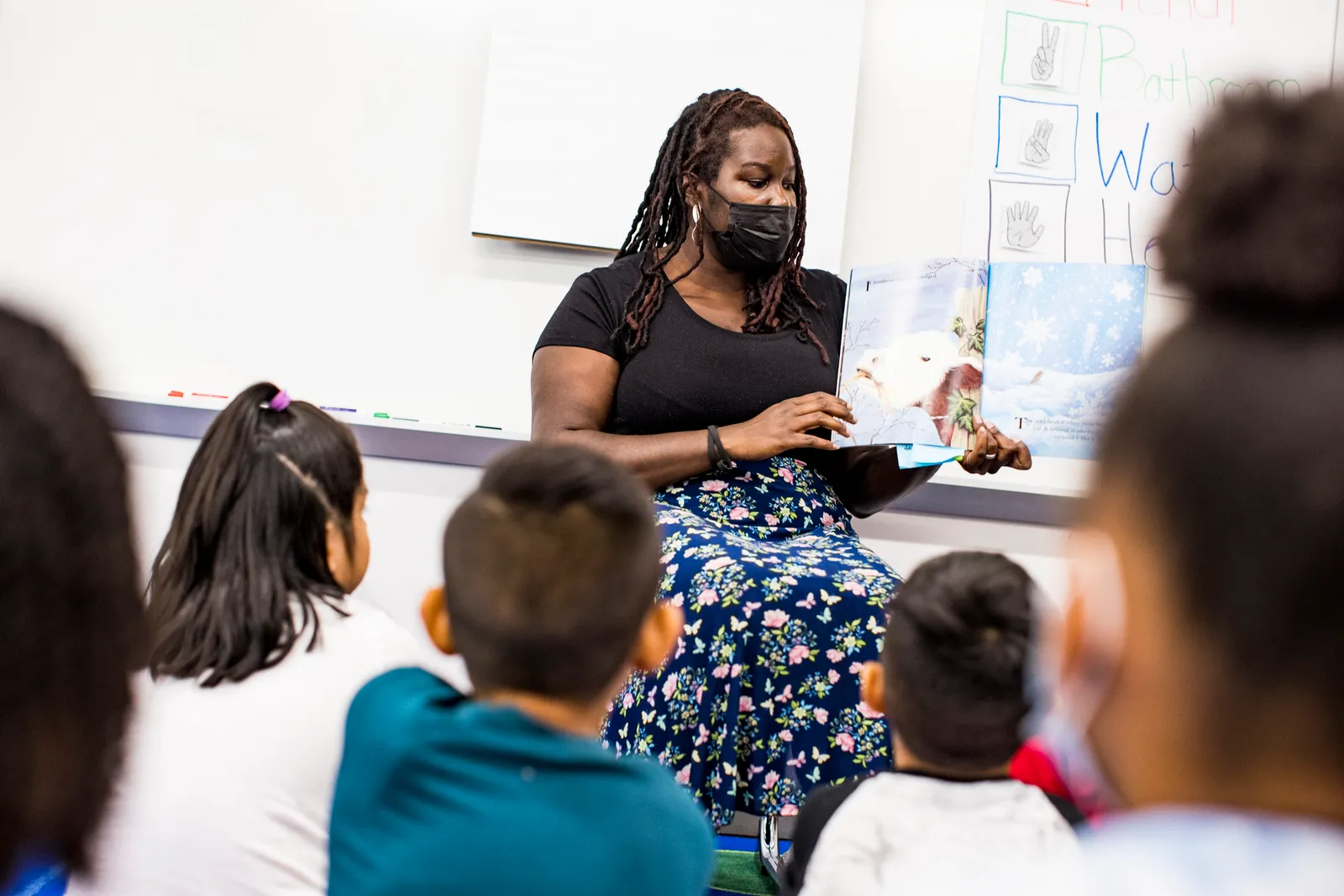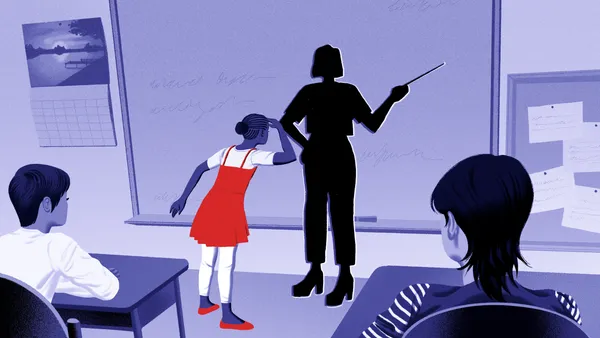This is the second installment in an ongoing series focused on examining solutions to the education workforce shortage. For the previous installment, click here.
Seven years ago, Ashley Lawrence Brooks, then a public health worker, noticed inequities and health disparities among older adults who didn't know how to read. This revelation would set her on the path to becoming a teacher for Baltimore City Public Schools.
At the same time, Lawrence Brooks was expecting her first child and began researching the district, knowing her daughter would eventually attend a BCPS school. As Lawrence Brooks learned more, her interest in starting a career in education was sparked further.
Lawrence Brooks already had a bachelor’s and a master’s degree, but neither were in teaching. As she began looking for ways to enter the education field, Lawrence Brooks wanted to find the “quickest” and least expensive option for switching professions.
That’s when she found the Baltimore City Teaching Residency, or BCTR, an alternative teaching certification program partnering with BCPS, where she became a cohort teaching resident in the summer of 2015. Since then, Lawrence Brooks has taught full time at the elementary level in the district.

The 20-year-old Baltimore residency program requires applicants to hold at least a bachelor’s degree with a minimum undergraduate grade point average of 2.0. The program is run through the nonprofit TNTP Teaching Fellows. Participants must pay $7,000 to cover a six-week summer training program to prepare them for entering the classroom in the fall and year-long certification coursework during which they typically meet weekly.
“The six weeks were intense. The days were long, but the weeks went by very quickly,” Lawrence Brooks said. “We dived right into the content the first day, and the following week I was in front of students teaching for at least an hour each day.”
Recruiting teachers in high-needs schools
Between 2002 and 2021, 2,576 Baltimore residents enrolled in the program, according to Molly Burke, senior manager of regional communications at TNTP.
BCTR is one of three alternative teaching certification programs that partners with the Baltimore district, said Sarah Diehl, executive director of recruitment and staffing at BCPS. The others are Teach for America and Urban Teachers, she said.
Alternative certification programs provide the district with a significant percentage of teachers in higher-need content areas, such as math and special education, Diehl said.
“Were we not to partner with these programs, with BCTR, I do anticipate that there are some number of vacancies in high-needs content areas or high-needs schools that would otherwise go unfilled,” Diehl said.
Enrollment of BCTR residents declines during COVID-19 pandemic
The No. 1 goal of the Baltimore fellows program is to supply teachers to the district’s high-needs schools, said Johari Toe, who directs the program for TNTP.
“The way we retain adults is to make sure that they understand what they’re walking into, that they understand the environment that they’re about to be connected with,” Toe said. “Although we can’t speak for the diverse needs of every single Baltimore City public school that they’re going to walk into, we do spend a lot of time teaching them about the history of Baltimore.”
That includes teaching residents about past and present systemic racism that still impacts the city, she said, adding it’s important to “learn the people” and “learn the community.”
This summer, Adam Weeks completed training as a Baltimore fellow and began teaching 2nd grade students in a city school this fall. As Weeks prepared his classroom before school opened Aug. 29, he said he felt ready to handle a class full of students.
“I feel like I have a unique understanding of Baltimore students and the best way to teach them,” Weeks said. “BCTR is really great about telling [and] being honest about the state of Baltimore and education in Baltimore and preparing you to work in that, because it’s a very unique place.”
Supporting Black educators
However, it isn’t always easy for people to take 6 weeks out of work and lose that pay, said Lawrence Brooks, now a 1st grade teacher at Johnston Square Elementary.
“Luckily I had the support of our family to be able to do the program at that time, but I know that many other people struggled financially making it through the program,” Lawrence Brooks said.
When she did the fellows program in 2015, Lawrence Brooks said many of her Black cohort members did not make it through. In addition to not being able to afford to be unemployed for six weeks, she said, it can also be difficult to afford to pay for the Praxis teacher certification exams, or they ran out of time to pass the exam and complete the program.
But in 2019, Baltimore became one of the first TNTP sites to establish a Black Educator Excellence Cohort, which seeks to address some of these barriers, said Jack Perry, a TNTP partner for the Northeast region. The program launched with the help of a philanthropic grant, he said.
The Black Educator Excellence Cohort provides financial assistance to aspiring Black educators in the TNTP programs, as well as additional support for required certification exams through practice tests and tutoring. Program leaders also describe it as an affinity group for Black educators to build community and foster mentorships.
Lawrence Brooks, who is Black, said she wished the cohort had existed when she went through the program. Opportunities like this are important because they can help ensure students eventually have teachers who look like them, she said.
A 2019 report created through a one-year analysis by a BCPS Black Teacher Recruitment and Retention Work Group found a persistent representation gap between the percentage of Black teachers and Black students in the district. At the time, 45% of BCPS teachers were Black, compared to the 80% of students, the report found.
From 2018 to 2020, more than 60% of BCTR participants were teachers of color, according to data provided by the program. But that percentage dropped to 41% in 2021, a year after the pandemic began.
For 3 years, residents of color made up the majority of those enrolled in BCTR
“We saw, like many other programs like us, that once the pandemic hit, there were less folks coming to our programs, and we’ve not quite recovered from that yet,” Perry said. “There are more concentrated efforts in funding coming down the pike to address this very issue because it’s needed.”
No one-size-fits-all approach
The need is there to hire more teachers who look like their students, said Christopher Morphew, dean of the Johns Hopkins School of Education in Baltimore.
Still, alternative certification programs that aim to get teachers in the classroom quickly can “run the risk of sending the message that this is not a highly skilled profession and that teaching is easy — because it’s not,” Morphew said.
“On the other hand, we clearly need these programs,” Morphew said, noting the ongoing teacher shortage.
For Toe, there’s not a one-size-fits-all model to becoming an educator. If aspiring teachers want to get a master’s degree, Toe said they should pursue that.
“If we go back to that place, we end up shutting the door on more people than opening the door,” Toe said. “The moment we try to create this lane of what it should only look like is when we end up hurting ourselves.”
Enrollment in Maryland educator preparation programs has declined 33% since 2012, according to the state’s department of education.
“What I think that means from a district perspective is that we really need to rely on multiple avenues, multiple strategies in order to be able to hire enough teachers to fill our vacancies,” Diehl said.
It’s helpful for principals when their teachers come from a variety of backgrounds, too, she said.
BCPS also follows traditional paths of recruiting from all Maryland colleges and universities, as well as participating in 30 hiring events at schools in other states, Diehl said. The district works with historically Black colleges and universities to recruit teachers, too, and has hired a small cohort of teachers from the Philippines on J-1 visas.
“We’re casting a very, very wide net and it seems like the yield is a little bit lower than it’s been in the past, and I think that we’re going to have to be more nuanced and even more creative and even more long-ranging in our recruitment strategies,” Diehl said. “I don’t necessarily see this trend of increased challenges with teacher recruitment going away anytime soon.”










